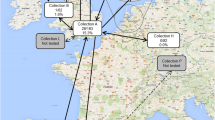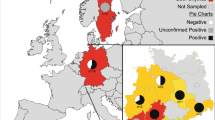Abstract
There is increasing evidence that the global spread of the fungal pathogen Batrachochytrium dendrobatidis (Bd) has been facilitated by the international trade in amphibians. Bd was first detected in the UK in 2004, and has since been detected in multiple wild amphibian populations. Most amphibians imported into the UK for the pet trade from outside the European Union enter the country via Heathrow Animal Reception Centre (HARC), where Bd-positive animals have been previously detected. Data on the volume, diversity and origin of imported amphibians were collected for 59 consignments arriving at HARC between November 2009 and June 2012, along with a surveillance study to investigate the prevalence of Bd in these animals. Forty-three amphibian genera were recorded, originating from 12 countries. It was estimated that 5000–7000 amphibians are imported through HARC into the UK annually for the pet trade. Bd was detected in consignments from the USA and Tanzania, in six genera, resulting in an overall prevalence of 3.6%. This suggests that imported amphibians are a source of Bd within the international pet trade.

Similar content being viewed by others
References
Balaz V, Voeroes J, Civis P, Vojar J, Hettyey A, Sos E, Dankovics R, Jehle R, Christiansen DG, Clare F, Fisher MC, Garner TWJ, Bielby J (2014) Assessing risk and guidance on monitoring of Batrachochytrium dendrobatidis in Europe through identification of taxonomic selectivity of infection. Conservation Biology 28:213–223
Berger L, Speare R, Daszak P, Greene DE, Cunningham AA, Goggin CL, Slocombe R, Ragan MA, Hyatt AD, McDonald KR, Hines HB, Lips KR, Marantelli G, Parkes H (1998) Chytridiomycosis causes amphibian mortality associated with population declines in the rain forests of Australia and Central America. Proc Natl Acad Sci USA 95:9031–9036
Bielby J, Bovero S, Angelini C, Favelli M, Gazzaniga E, Perkins M, Sotgiu G, Tessa G, Garner TWJ (2013) Geographic and taxonomic variation in Batrachochytrium dendrobatidis infection and transmission within a highly endemic amphibian community. Divers Distrib 19:1153–1163
Broad S, Mulliken T, Roe D (2003) The nature and extent of legal and illegal trade in wildlife. In: Oldfield S (Eds) The trade in wildlife: regulation for conservation, London: Earthscan Publications, pp 3–22
Cannon R, Roe R (1982) Livestock disease surveys: a field manual for veterinarians, Canberra, Australia: Australian Bureau of Animal Health
Catenazzi A, Lehr E, Vredenburg VT (2014) Thermal physiology, disease, and amphibian declines on the eastern slopes of the Andes. Conserv Biol 28:509–517
Cunningham, A. A., Daszak, P. and Rodríguez, J. P. (2003) Pathogen pollution: defining a parasitological threat to biodiversity conservation. J Parasitol 89, S78-S83
Cunningham AA, Garner TWJ, Aguilar-Sanchez V, Banks B, Foster J, Sainsbury AW, Perkins M, Walker SF, Hyatt AD, Fisher MC (2005) Emergence of amphibian chytridiomycosis in Britain. Vet Record 157:386-387
Daszak P, Cunningham AA, Hyatt AD (2000) Emerging infectious diseases of wildlife - threats to biodiversity and human health. Science 287:443-449
Daszak P, Cunningham AA, Hyatt, AD (2001) Anthropogenic environmental change and the emergence of infectious diseases in wildlife. Acta Tropica 78:103-116
Dobson A, Foufopoulos J (2001) Emerging infectious pathogens of wildlife. Philos Trans R Soc B 356:1001-1012
Farrer RA, Weinert LA, Bielby J, Garner TWJ, Balloux F. Clare F, Bosch J, Cunningham AA, Weldon C, Du Preez LH, Anderson L, Pond SLK, Shahar-Golan R, Henk DA, Fisher MC (2011) Multiple emergences of genetically diverse amphibian-infecting chytrids include a globalized hypervirulent recombinant lineage. Proc Natl Acad Sci USA 108:18732-18736
Fèvre EM, Bronsvoort BMDC, Hamilton KA, Cleaveland S (2006) Animal movements and the spread of infectious diseases. Trends Microbiol 14:125-131
Fisher MC, Garner TWJ (2007) The relationship between the emergence of Batrachochytrium dendrobatidis, the international trade in amphibians and introduced amphibian species. Fungal Biol Rev 2:2-9
Garland S, Baker A, Phillott AD, Skerratt, LF (2010) BSA reduces inhibition in a TaqMan (R) assay for the detection of Batrachochytrium dendrobatidis. Dis Aquat Org 92:113-116
Garner TWJ, Perkins MW, Govindarajulu P, Seglie D, Walker S, Cunningham AA, Fisher MC (2006) The emerging pathogen Batrachochytrium dendrobatidis globally infects introduced populations of the North American bullfrog, Rana catesbeiana. Biol Lett 2:455-459
Goka K, Yokoyama J, Une Y, Kuroki T, Suzuki K, Nakahara M, Kobayashi A, Inaba S, Mizutani T, Hyatt AD (2009). Amphibian chytridiomycosis in Japan: distribution, haplotypes and possible route of entry into Japan. Mol Ecol 18:4757-4774
Gummow B (2010) Challenges posed by new and re-emerging infectious diseases in livestock production, wildlife and humans. Livest Sci 130:41-46
Hyatt AD, Boyle DG, Olsen V, Boyle DB, Berger L, Obendorf D, Dalton A, Kriger K, Hero M, Hines H, Phillott R, Campbell R, Marantelli G, Gleason F, Colling A (2007) Diagnostic assays and sampling protocols for the detection of Batrachochytrium dendrobatidis. Dis Aquat Org 73:175-192
Karesh WB, Cook RA, Bennett EL, Newcomb J (2005) Wildlife trade and global disease emergence. Emerg Infect Dis 11:1000-1002
Kindt R, Coe R (2005) Tree diversity analysis. A manual and software for common statistical methods for ecological and biodiversity studies. World Agroforestry Centre (ICRAF), Nairobi
Kolby JE, Smith KM, Berger L, Karesh WB, Preston A, Pessier AP, Skerratt LF (2014) First evidence of amphibian chytrid fungus (Batrachochytrium dendrobatidis) and ranavirus in Hong Kong amphibian trade. PLoS One 9(3):e90750
Lips KR, Burrowes PA, Mendelson JR, Parra-Olea G (2005) Amphibian population declines in Latin America: A synthesis. Biotropica 11:222-226
Liu X, Rohr JR, Li YM (2013) Climate, vegetation, introduced hosts and trade shape a global wildlife pandemic. Proc R Soc B 280: 20122506
MacDiarmid SCB (2011) The spread of pathogens through international trade. Revue Scientifique Et Technique 30:13-17
Martel A, Blooi M, Adriaensen C, Van Rooij P, Beukema W, Fisher MC, Farrer RA, Schmidt BR, Tobler U, Goka K, Lips KR, Muletz C, Zamudio K, Bosch J, Lotters S, Wombwell E, Garner TWJ, Cunningham AA, Spitzen-van der Sluijs A, Salvidio S, Ducatelle R, Nishskawa K, Nguyen TT, Kolby JE, Van Bocxlaer I, Bossuyt F, Pasmans F (2014) Recent introduction of a chytrid fungus endangers Western Palearctic salamanders. Science 346 (6209):630-631
Martel A, Spitzen-Van der Sluijs A, Blooi M, Bert W, Ducatelle R, Fisher MC, Woeltjes A, Bosman W, Cheirs K, Bossuyt F, Pasmans F (2013) Batrachochytrium salamandrivorans sp nov causes lethal chytridiomycosis in amphibians. Proc Natl Acad Sci USA 110:15325-15329
OIE (2006) Report of the meeting of the OIE Aquatic Animal Health Standards Commission. http://www.oie.int/doc/en_document.php?numrec=3342703
OIE (2008) Report of the meeting of the OIE Aquatic Animal Health Standards Commission. http://www.oie.int/doc/ged/D4647.PDF
OIE (2012) Infection with Batrachochytrium dendrobatidis. In: OIE (ed) Aquatic animal health code. 15th edn. Office International des Epizooties, Paris
Peel AJ, Hartley M, Cunningham AA (2012) Qualitative risk analysis of introducing Batrachochytrium dendrobatidis to the UK through the importation of live amphibians. Dis Aquat Org 98:95-112
Picco AM, Collins JP (2008) Amphibian commerce as a likely source of pathogen pollution. Conserv Biol 22:1582-1589
Pounds JA, Bustamante MR, Coloma LA, Consuegra JA, Fogden MPL, Foster PN, La Marca E, Masters KL, Merino-Viteri A, Puschendorf R, Ron SR, Sanchez-Azofeifa GA, Still CJ, Young BE (2006) Widespread amphibian extinctions from epidemic disease driven by global warming. Nature 439:161-167
Price SJ, Garner TW, Nichols RA, Balloux F, Ayres C, Mora-Cabello de Alba A, Bosch J (2014) Collapse of amphibian communities due to an introduced ranavirus. Curr Biol 24:2586-2591
R Development Core Team (2014) R: a language and environment for statistical computing. R Foundation for Statistical Computing, Vienna, Austria. http://www.R-project.org
Roe D, Mulliken T, Milledge S, Mremi J, Mosha S, Greig-Gran M (2002) Making a killing or making a living? Wildlife trade, controls and rural livelihoods. London: International Institute for Environment and Development
Rosen GE, Smith KF (2010) Summarizing the evidence on the international trade in illegal wildlife. EcoHealth 7:24-32
Schiøtz A, Poynton J, Howell K (2008) Hyperolius puncticulatus. The IUCN Red List of Threatened Species. Version 2014.3. http://www.iucnredlist.org/details/56187/0
Schlaepfer MA, Hoover C, Dodd, CK (2005) Challenges in evaluating the impact of the trade in amphibians and reptiles on wild populations. Bioscience 55:256-264
Schloegel LM, Picco AM, Kilpatrick AM, Davies AJ, Hyatt AD, Daszak P (2009) Magnitude of the US trade in amphibians and presence of Batrachochytrium dendrobatidis and ranavirus infection in imported North American bullfrogs (Rana catesbeiana). Biol Conserv 142:1420-1426
Schloegel LM, Daszak P, Cunningham AA, Speare R, Hill B (2010) Two amphibian diseases, chytridiomycosis and ranaviral disease, are now globally notifiable to the World Organization for Animal Health (OIE): an assessment. Dis Aquat Org 92:101-108
Skerratt LF, Berger L, Speare R, Cashins S, Mcdonald KR, Phillott AD, Hines HB, Kenyon N (2007) Spread of chytridiomycosis has caused the rapid global decline and extinction of frogs. EcoHealth 4:125-134
Smith F (2013) Epidemiology of chytridiomycosis in Britain. Ph.D. Thesis, University of London, UK
Swift L, Hunter PR, Lees AC, Bell DJ (2007) Wildlife trade and the emergence of infectious diseases. EcoHealth 4:25-30
Wombwell E (2008) The amphibian trade: a conservation concern? M.Sc. Thesis, Royal Veterinary College, London, UK
Zepeda C, Salman M, Ruppanner R(2001) International trade, animal health and veterinary epidemiology: challenges and opportunities. Prev Vet Med 48:261-271
Acknowledgments
This study was funded by the UK government’s Department for Environment, Food and Rural Affairs, grant FC1195, and by the EU BiodivERsA-funded project R.A.C.E. (Risk Assessment of Chytridiomycosis to European amphibian biodiversity). EW was supported by a Natural Environment Research Council and Economic and Social Research Council Interdisciplinary PhD studentship.
Author information
Authors and Affiliations
Corresponding author
Rights and permissions
About this article
Cite this article
Wombwell, E.L., Garner, T.W.J., Cunningham, A.A. et al. Detection of Batrachochytrium dendrobatidis in Amphibians Imported into the UK for the Pet Trade. EcoHealth 13, 456–466 (2016). https://doi.org/10.1007/s10393-016-1138-4
Received:
Revised:
Accepted:
Published:
Issue Date:
DOI: https://doi.org/10.1007/s10393-016-1138-4




